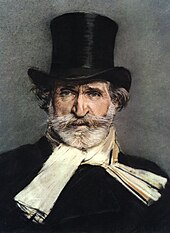Giuseppe Verdi's Human Design Chart
3/5 Splenic ProjectorItalian musician and composer who became known as the Grand Old Man of Italian opera. His first opera, “Oberto,” was written at the age of 20 and was followed by 30 more, including “Rigoletto,” 1851, La Traviata,” 1853, “Aida,” 1871 and “Falstaff,” 1893.
Verdi’s dad was keeper of a tavern and grocery, illiterate and too poor to give his son an education. However the boy showed his musical gift at an early age and attracted the attention of Antonio Barezzi, a merchant who loved music. Barezzi helped Giuseppe with his education. At 18, he went to Milan to study for three years.
Verdi took the post of musical director of Busseto, near his birth village, and in 1836, he married the daughter of his patron, Margherita Barezzi. He had an opera produced in 1839 that was so successful that he was commissioned to compose three more for the Milanese theater.
His work came to a tragic stop, however, when he lost his family. He and his first wife Margherita (who died 6/18/1840) had two children, Virginia (3/26/1837 – 8/12/1838) and Icilio Romano (11/11/1838 – 10/22/1839). His opera “un giorno di regno” was a total flop that was soundly jeered by the audience on 9/05/1840, leaving a lasting psychological imprint on his attitude toward critics and the press. Overcome with despair, he vowed he would never compose again.
Two years later, he reluctantly accepted a commission. The result established his reputation in Italy with the release of “Nabucco,” in 1842, taking him to Paris where he lived from 1847-1849.
He returned to Busseto with his mistress, Giuseppina Strepponi. Now a man of some wealth, he purchased Sant’Agata, which was his home for the rest of his life. After a scandal-ridden interlude in which both Verdi and Strepponi seemed reluctant to marry, they finally legalized their union in 1859.
From 1855, Verdi reigned as an international figure and outstanding success. With more patriotism than taste for politics, he agreed to run for office and was elected to Parliament in 1861, but took no active role and resigned in 1865. After his “Four Sacred Pieces” in 1898, he wrote no more. His beloved wife had died the prior year, and he himself was failing in strength.
Died on 1/27/1901, Milan, Italy
Link to Wikipedia biography
Discover More Famous People
Browse and analyze over 55,000 public figures and celebrities.
Ra Uru Hu
5/1 Manifestor
Martha Stewart
4/6 Manifestor
David Lynch
4/6 Generator
Barack Obama
6/2 Projector
Steve Jobs
6/3 Generator
Vladimir Putin
5/1 Manifestor
Kim Kardashian
3/5 Generator
Michael Jackson
1/3 Projector
Marilyn Monroe
6/2 Projector
Ariana Grande
2/4 Projector
Oprah Winfrey
2/4 Generator
Johnny Depp
2/4 ManifestorWhat is HumanDesign.ai and how does it work?
Curious what makes Giuseppe Verdi tick? HumanDesign.ai instantly maps their exact birth data into a fully interactive clickable bodygraph chart, letting you hover or tap every center, channel, and gate for plain-language explanations. Bella, the platform’s built-in AI guide, adds context in real time, translating complex mechanics into everyday insights so you can see how Giuseppe Verdi’s strengths, challenges, and life themes play out on-screen.
The same tools are waiting for you. Generate your own Human Design Chart in seconds, open a library of 2000+ suggested questions, and chat with Bella as often as you like to decode your design, daily transits, and even relationship dynamics.
Want to compare energies? Save unlimited charts for friends, family, or clients, then ask Bella to reveal compatibilities, composite patterns, or coaching tips, all in one conversation thread.
Start free with core features, or unlock our Personal and Pro plans for deeper dives: unlimited Q&A, celebrity chart search spanning 55,000+ public figures, white-label PDF reports, branded content generation, and a professional profile with built-in booking for practitioners. Whether you’re exploring your own potential or guiding others, HumanDesign.ai delivers an ever-expanding toolbox of AI-powered insights—no spreadsheets, no jargon, just clarity at your fingertips.
Ready to see yours? Signup for FREE today!

